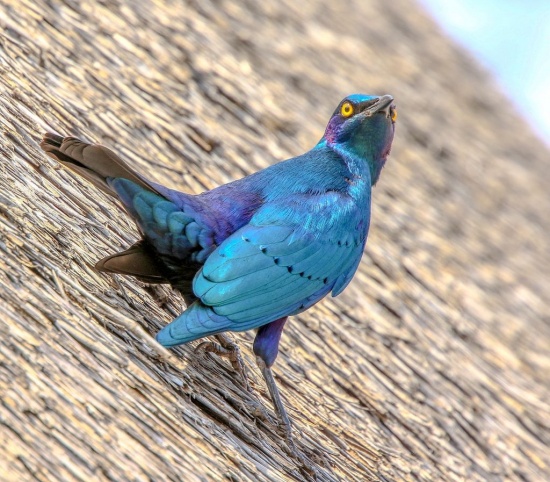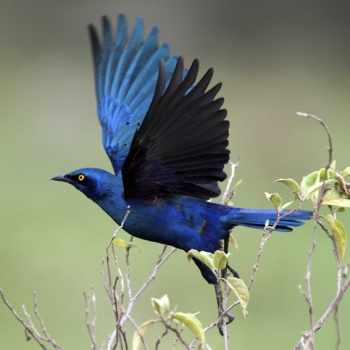Alternative name: Greater Blue-eared Glossy Starling
- Lamprotornis chalybaeus
Identification
21-24 cm (8¼-9½ in). A rather large starling with a relatively short tail.
- Blue-green forehead, crown, nape and upperparts
- Blackish lores
- Glossy-blue ear-coverts forming a distinctive patch
- Blue-green wings
- Glossy-blue green chin, throat, breast and undertail-coverts
- Blue flanks, belly and tighs with violet sheen.
- White to yellow to orange to red eye
- Black bill and legs
Sexes similar. Juveniles much duller.
Similar species
Lesser Blue-eared Glossy-Starling is smaller with a narrower ear patch and magenta belly and flanks. Bronze-tailed Glossy-Starling has a shorter tail and a darker orange-yellow eye. Cape Glossy-Starling has green ear patches, belly and flanks.
Distribution
Sub-Saharan Africa:
Western Africa: found in Mauritania, Senegal, The Gambia, Mali, Ivory Coast, Burkina Faso, Ghana, Togo, Nigeria, Niger, Chad, Cameroon, Democratic Republic of Congo, Angola, Zaire
Eastern Africa: Sudan, South Sudan, Eritrea, Ethiopia, Somalia, Kenya, Uganda, Rwanda, Burundi, Tanzania, Zambia, Mozambique, Malawi
Southern Africa: Namibia, Botswana, Zimbabwe, South Africa, KwaZulu-Natal
Common in most of its range.
Taxonomy
Subspecies
Lamprotornis chalybaeus has four subspecies:1
- L. c. chalybaeus
- L. c. cyaniventris
- L. c. sycobius
- South-western Uganda to south-eastern Kenya, Tanzania, south-eastern Zaire and Mozambique
- L. c. nordmanni
- Southern Angola to Zimbabwe, southern Zambia, Botswana and north-eastern South Africa
Habitat
Dry savanna woodland, in some regions extending into desert.
Occurs largely above 500m.
Behaviour
Forages, often in flocks, on the ground and in trees.
Diet
Eats fruit, nectar and insects.
Breeding
Monogamous. The nest is built in a cavity (often an old woodpecker or barbet nest) in a tree. Two to five eggs are incubated for 13-14 days by the female.
parasitised by the Great Spotted Cuckoo and Greater Honeyguide.
Vocalisation
The song is rambling with a whining tone. The call is nasal squee-aar.
References
- Clements, J. F., T. S. Schulenberg, M. J. Iliff, D. Roberson, T. A. Fredericks, B. L. Sullivan, and C. L. Wood. 2018. The eBird/Clements checklist of birds of the world: v2018. Downloaded from http://www.birds.cornell.edu/clementschecklist/download/
- Hockey, PAR, WRJ Dean, and PG Ryan, eds. 2005. Roberts' Birds of Southern Africa. 7th ed. Cape Town: John Voelcker Bird Book Fund. ISBN 978-0620340533
- Sinclair, I and P Ryan. 2003. Birds of Africa South of the Sahara. Princeton: Princeton Univ. Press. ISBN 978-0691118154
- Del Hoyo, J, A Elliott, and D Christie, eds. 2009. Handbook of the Birds of the World. Volume 14: Bush-shrikes to Old World Sparrows. Barcelona: Lynx Edicions. ISBN 978-8496553507
- Avibase
Recommended Citation
- BirdForum Opus contributors. (2024) Greater Blue-eared Starling. In: BirdForum, the forum for wild birds and birding. Retrieved 27 April 2024 from https://www.birdforum.net/opus/Greater_Blue-eared_Starling
External Links
GSearch checked for 2020 platform.1






